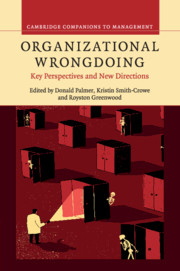Book contents
- Frontmatter
- Contents
- List of figures
- List of tables
- List of contributors
- Foreword
- 1 The imbalances and limitations of theory and research on organizational wrongdoing
- 2 On taking the theoretical substance of outcomes seriously: a meta-conversation
- 3 Wrong paths to right: defining morality with or without a clear red line
- 4 From market enablers to market participants: redefining organizational and political-legal arrangements and opportunities for financial wrongdoing,1930s–2000
- 5 Wrongdoing and market development: an examination of the distinct roles of trust and distrust
- 6 Bad apples, bad barrels and bad cellars: a “boundaries” perspective on professional misconduct
- 7 S/he blinded me with science: the sociology of scientific misconduct
- 8 Social networks and organizational wrongdoing in context
- 9 Falling stars: celebrity, infamy, and the fall from (and return to) grace
- 10 Compensation and employee misconduct: the inseparability of productive and counterproductive behavior in firms
- 11 Beware of organizational saints: how a moral self-concept may foster immoral behavior
- 12 “Is it me? Or is it me?” The role of coactivated multiple identities and identifications in promoting or discouraging workplace crimes
- 13 Consequences of organizational misconduct: too much and too little punishment
- 14 Who bears the brunt? A review and research agenda for the consequences of organizational wrongdoing for individuals
- 15 Organizational wrongdoing and media bias
- 16 Ethical learning: releasing the moral unicorn
- Index
- References
3 - Wrong paths to right: defining morality with or without a clear red line
Published online by Cambridge University Press: 05 July 2016
- Frontmatter
- Contents
- List of figures
- List of tables
- List of contributors
- Foreword
- 1 The imbalances and limitations of theory and research on organizational wrongdoing
- 2 On taking the theoretical substance of outcomes seriously: a meta-conversation
- 3 Wrong paths to right: defining morality with or without a clear red line
- 4 From market enablers to market participants: redefining organizational and political-legal arrangements and opportunities for financial wrongdoing,1930s–2000
- 5 Wrongdoing and market development: an examination of the distinct roles of trust and distrust
- 6 Bad apples, bad barrels and bad cellars: a “boundaries” perspective on professional misconduct
- 7 S/he blinded me with science: the sociology of scientific misconduct
- 8 Social networks and organizational wrongdoing in context
- 9 Falling stars: celebrity, infamy, and the fall from (and return to) grace
- 10 Compensation and employee misconduct: the inseparability of productive and counterproductive behavior in firms
- 11 Beware of organizational saints: how a moral self-concept may foster immoral behavior
- 12 “Is it me? Or is it me?” The role of coactivated multiple identities and identifications in promoting or discouraging workplace crimes
- 13 Consequences of organizational misconduct: too much and too little punishment
- 14 Who bears the brunt? A review and research agenda for the consequences of organizational wrongdoing for individuals
- 15 Organizational wrongdoing and media bias
- 16 Ethical learning: releasing the moral unicorn
- Index
- References
Summary
The moral terrain of organizational life is often conceived as divided by a clear red line, with rightdoing on one side and wrongdoing on the other. Like highway markings, this line is bright and unambiguous, laid down by social control agents – mostly compliance officers or state officials – to ensure adherence to a specific order and to sanction definitions of right and wrong. Organizational actors may be drawn across the line for reasons of self-enrichment or competitive pressures. They may also find themselves on the wrong side by mistake (Vaughan 1999; Warren and Smith-Crowe 2008), as when they do not recognize what they are doing as having ethical implications (Bazerman and Gino 2012; Tenbrunsel and Smith-Crowe 2008), or when they are lured across the line by social control agents looking to uncover and punish wrongdoing (Palmer 2012). Regardless of the reasons, once organizational actors find themselves on the wrong side of the line, the moral order perspective leaves little doubt that their actions will be labeled as wrongdoing (Greve, Palmer, and Pozner 2010: 56).
This vision of a clear and decisive moral order is at best incomplete, and we know that morality and immorality in organizations – defined as what a community deems right or wrong (Durkheim 1973; Mauss 1967) – are often more equivocal. For example, organizational actors frequently face moral dilemmas in which the right thing to do is unclear because different sets of moral prescriptions or principles conflict, or because their consciously reasoned moral response is contradicted by an emotional reaction about what “feels” wrong (Greene 2014; Walzer 1973; Winston 2015). These examples highlight a more general observation: the location of a line separating right from wrong is not a concrete absolute but something determined through people's interactions and therefore relative, disputed, and dynamic. Indeed, many organizations intentionally avoid establishing an explicit definition of right and wrong, or at least one that is easily identifiable and applies to all members, and instead allow each individual to draw his or her own line. We conceptualize such organizations as “moral pursuits” (Anteby 2013: 130–134), in which rightdoing involves an ongoing pursuit of personal morality and wrongdoing is in the eye of each individual beholder. We distinguish these from moral orders, in which rightdoing and wrongdoing are defined ex ante by social control agents.
- Type
- Chapter
- Information
- Organizational WrongdoingKey Perspectives and New Directions, pp. 47 - 76Publisher: Cambridge University PressPrint publication year: 2016
References
- 5
- Cited by



